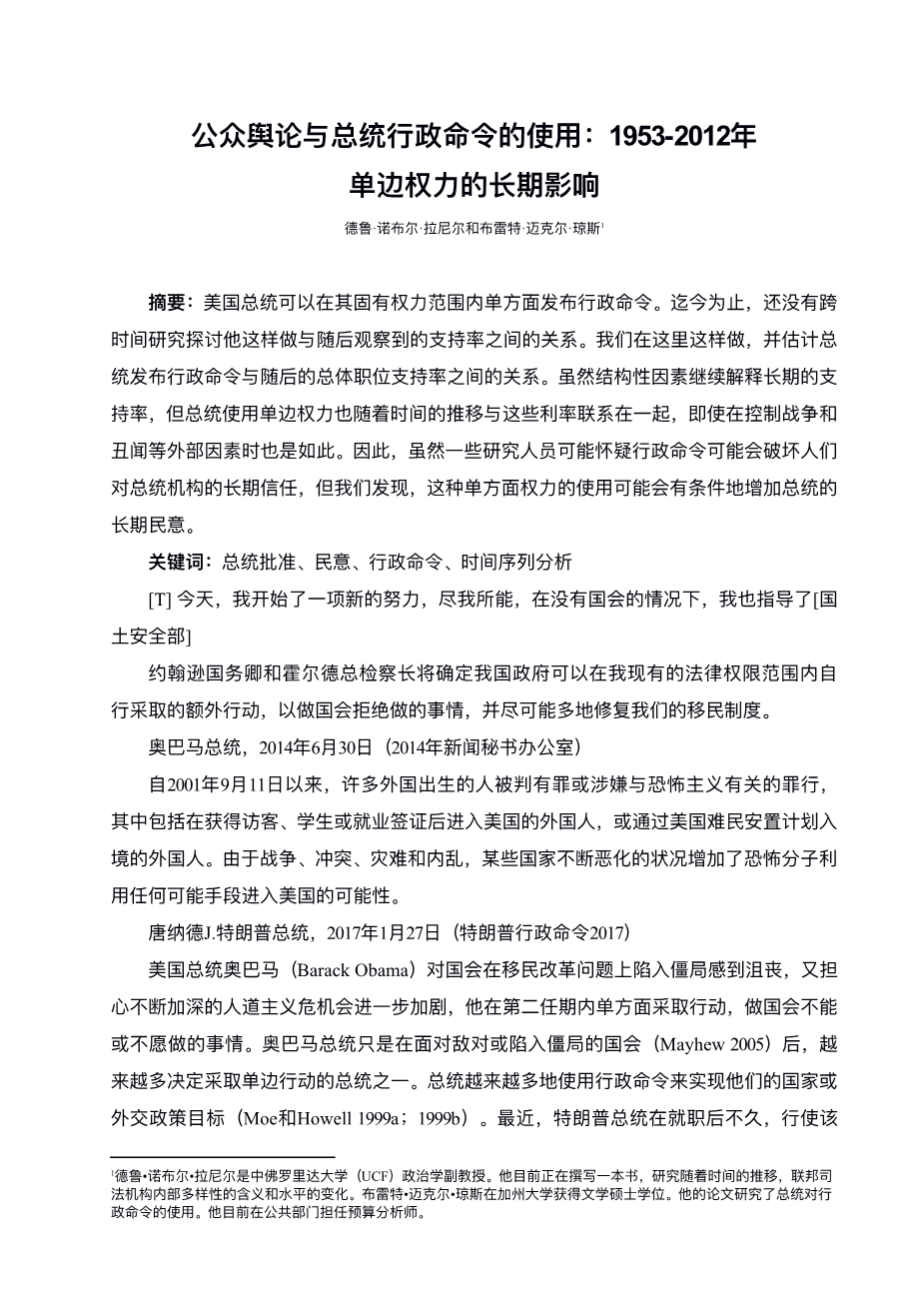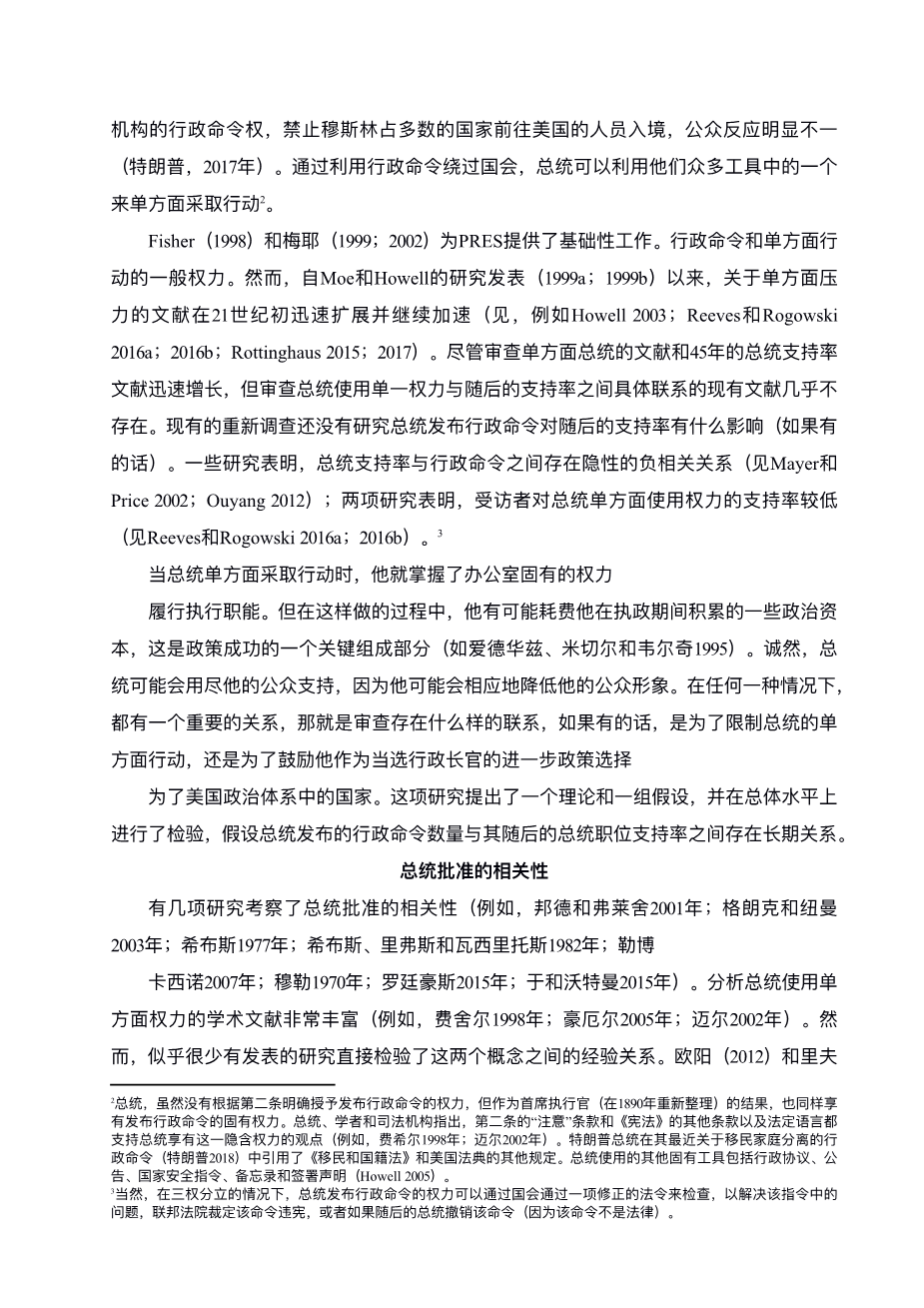The Law
Public Opinion and the Presidentrsquo;s Use of Executive Orders: The Long-Run Impact of Unilateral Powers, 1953–2012
DREW NOBLE LANIER and BRETT MICHAEL JONES
The U.S. president may act unilaterally in issuing executive orders within the officersquo;s inherent powers. To date, no cross-time study has explored the relationship of his doing so with subsequent observed approval ratings. We do so here and estimate the relationship between the presidentrsquo;s issuing of executive orders and subsequent job approval ratings at the aggregate level. While structural factors continue to explain long-run approval rates, the presidentrsquo;s use of unilateral powers also is associated through time with those rates, even when controlling for external factors such as wars and scandals. Thus, while some researchers may suspect that executive orders may undermine long-term confidence in the institution of the presidency, we find that such uses of unilateral power may conditionally lead to gains in long-term public opinion of the president.
Keywords: presidential approval, public opinion, executive orders, time series analysis
[T]oday, Irsquo;m beginning a new effort to fix as much of our immigration system as I can on my own, without Congress I have also directed [Homeland Security]
Secretary Johnson and Attorney General Holder to identify additional actions my administration can take on our own, within my existing legal authorities, to do what Congress refuses to do and fix as much of our immigration system as we can.
President Barack Obama, June 30, 2014 (Office of the Press Secretary 2014)
Numerous foreign-born individuals have been convicted or implicated in terror- ism-related crimes since September 11, 2001, including foreign nationals who en- tered the United States after receiving visitor, student, or employment visas, or who entered through the United States refugee resettlement program. Deteriorating conditions in certain countries due to war, strife, disaster, and civil unrest increase the likelihood that terrorists will use any means possible to enter the United States.
President Donald J. Trump, January 27, 2017 (Trump Executive Order 2017)
Drew Noble Lanier is an associate professor of political science at the University of Central Florida (UCF). He is currently working on a book examining the changing meaning and levels of diversity within the federal judiciary over time. Brett Michael Jones earned his M.A. at UCF. His thesis examined the presidentrsquo;s use of executive orders. He is presently using his skills as a budget analyst in the public sector.
Presidential Studies Quarterly
845
DOI: 10.1111/psq.12501
Vol. 48, No. 4, December 2018, 845–859 copy; 2018 Center for the Study of the Presidency and Congress
Frustrated with a deadlocked Congress on immigration reform, and fearing the further growth of an ever-deepening humanitarian crisis, U.S. president Barack Obama, well into his second term, acted unilaterally to do what Congress could not or would not do. President Obama is only one of many presidents who have increasingly decided to act unilaterally after facing a hostile or deadlocked Congress (Mayhew 2005). Presidents have increasingly used executive orders to achieve their national or foreign policy goals (Moe and Howell 1999a; 1999b). More recently, President Trump, soon after his inauguration, wielded the institutionrsquo;s executive order power to ban entry into the nation of persons traveling to the United States from majority-Muslim coun- tries, to distinctly mixed public reaction (Trump 2017). By using executive orders to circumvent Congress, presidents are able to use one of their many tools to act unilaterally.1
Fisher (1998) and Mayer (1999; 2002) provided foundational work on the pres-
identrsquo;s general power of executive orders and unilateral action. Since Moe and Howellrsquo;s studies were published (1999a; 1999b), however, the literature on the unilateral pres- idency has expanded rapidly and continued to accelerate at the beginning of the twenty-first century (see, e.g., Howell 2003; Reeves and Rogowski 2016a; 2016b; Rottinghaus 2015; 2017). Despite the rapid growth of that literature examining the unilateral presidency, and 45 years of presidential approval ratings literature, the existing literature examining the specific link between the presidentrsquo;s use of unilat- eral powers and subsequent approval ratings is virtually nonexistent. Existing re- search has not examined what effect, if any, a presidentrsquo;s issuing of executive orders has on subsequent approval ratings. Some studies suggest an implicit negative rela- tionship between presidential approval ratings and executive orders (see Mayer and Price 2002; Ouyang 2012); two studies have demonstrated that survey respondents report lower approval ratings for the presidentrsquo;s unilateral power use (see Reeves and Rogowski 2016a; 2016b).2
When the president acts unilaterally, he seizes upon inherent powers of the office
to carry out the executive function. But in doing so, he risks expending some of the po- litical capital that he has accumulated in office, a key component of policy success (e.g., Edwards, Mitchell, and Welch 1995). To be sure, the president may exhaust his public support, as he may diminish his public image accordingly. In either situation, it is an important relationship to examine what link, if any, exists to either limit the presidentrsquo;s unilateral actions or embolden such further policy choices as he is the elected executive
-
Presidents, while not expressly given the power to issue executive orders under Article II, nonethe- less enjoy the inherent power to do so as a result of serving as chief executive (In re Neagle 1890). Presidents, scholars, and the judiciary
剩余内容已隐藏,支付完成后下载完整资料


英语译文共 15 页,剩余内容已隐藏,支付完成后下载完整资料
资料编号:[255250],资料为PDF文档或Word文档,PDF文档可免费转换为Word


